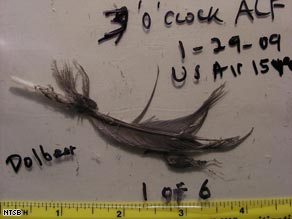
Capt. Chesley "Sully" Sullenberger’s run-in with a flock of Canada geese may be the most famous man-versus-nature story in recent months. But a federal database opened to the public Friday reveals just how commonplace airplanes’ encounters with wildlife are.
At New York’s LaGuardia Airport, where Sullenberger’s US Airways flight originated, planes hit birds nearly once a week on average, according to the records. But the number has grown from 16 hits in 1990 to 86 in 2008, according to the database. Nationwide, there were 98,328 reports of aircraft striking birds or other wildlife since January of 1990, although the actual numbers probably are far higher. The Federal Aviation Administration said only 20 percent of incidents are reported under the voluntary system of data collection. The database shows strikes resulted in “substantial damage” to aircraft on about 3,000 occasions. Eleven people died in incidents relating to bird strikes. The FAA initially fought to keep its database closed, saying publication of the details might discourage the industry from reporting information. After it was made public, an airline industry organization was quick to say the data could wrongly lead some people to believe flying is unsafe.
Bird strike dataA CNN check of the nation’s 50 busiest airports showed the following had the highest numbers of reported wildlife strikes during the 19-year period:
• Denver International, Colorado, 2,416
• Dallas-Fort Worth International, Texas, 2,376
• Chicago O’Hare, Illinois, 2,346
• JFK International, New York, 1,811
• Memphis International, Tennessee, 1,541
• Dulles International, Virginia, 1,204
• Salt Lake City International, Utah, 1,113
• Orlando International, Florida, 1,085
• San Francisco International, California, 1,021
• Pittsburgh International, Pennsylvania, 994
“While bird strikes have attracted a lot of attention, they are, of course, rare events. The vast majority of cases result in little or no aircraft damage,” said the Air Transport Association of America. A top pilots union — the Air Line Pilots Association — also had argued to keep the database closed. But the National Transportation Safety Board recommended opening up the data to the public. It also says reporting wildlife strikes should be mandatory. “If you strike a bird you really don’t have to report this to the FAA, which means we’re really not getting the full picture,” said Mark Rosenker, acting chairman of the safety board. The database includes information on more than 2,000 airports and 500 airlines and aircraft companies. When possible, it identifies the types of wildlife involved, chronicling the misadventures of 460 species. While bird strikes account for the majority of the mishaps, the database contains numerous aircraft encounters with deer, moose, caribou and even fish. According to the records, a fish hit a US Airways aircraft landing in Warwick, Rhode Island, in May of 2000. The fish had been dropped by an osprey. The FAA opted to make the database public after being pelted with criticism from passengers, media organizations and the National Transportation Safety Board, which investigates crashes. Interest in aviation bird strikes has been heightened by several recent incidents in addition to Sullenberger’s flight — the January 15 ditching of US Airways Flight 1549 in New York’s Hudson River. All on board survived. The transportation safety board says a bird strike may have preceded the crash of a Sikorsky helicopter near Morgan City, Louisiana, just 11 days earlier. The crash killed eight of the nine people aboard.